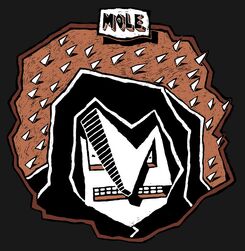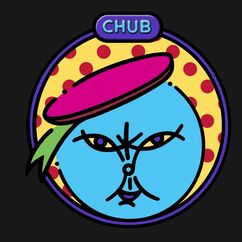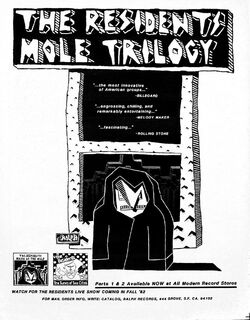The Mole Trilogy was a major multimedia project undertaken by The Residents from 1981 until 1985, which ultimately produced three studio albums (Part One: Mark of the Mole; Part Two: The Tunes of Two Cities; and Part Four: The Big Bubble), a live show which toured internationally, as well as a number of related spin-off releases.
The trilogy (which had originally been intended by The Residents to comprise six parts in total) depicts a multi-generational narrative focusing on two opposing races, the Moles and the Chubs, the contrasts between their respective cultures, and the social conflicts that occur after the Moles are forced out of their homes and into the Chubs' cities.
Despite the series comprising three completed studio albums (and rumors of a long-mooted, unfinished third entry), the trilogy of six parts remains unfinished. The Residents have stated that they do not have any intention to complete the series in the foreseeable future, and that they can no longer remember how they had intended to continue the series.[1]
History[]
Following the lukewarm reception of Commercial Album in 1980, The Residents decided to undertake a darker, more conceptual project of greater scale and magnitude. This venture resulted in the development of The Mole Trilogy. Originally intended to comprise three albums as a literal trilogy,[2] the concept expanded to include six albums following the release of the first entry in the series, Mark of the Mole, in 1981.
Each album conveying the narrative of the trilogy (Mark of the Mole and the unfinished parts three and five) would be followed by an album presenting the music of the trilogy's warring societies during the time period covered by the narrative of the preceding album (part two: The Tunes of Two Cities in 1982, part four: The Big Bubble in 1985, and the unfinished part six).
To date only parts 1, 2, and 4 of the trilogy of six have been completed and released, as well as the Intermission EP and The Mole Show live tour. Sections of music thought to originate from the unfinished part three were first heard on the digital release Mole Suite in 2011. Parts 5 and 6 are said to have been only roughly sketched out by the time the project was abandoned.[3]
The six-disc Mole Box set released in April 2019 as part of the group's pREServed reissue campaign includes a sequence of tracks which "may or may not" be part of the unreleased part three of the trilogy, including "Marching To The We", previously heard as part of Mole Suite.
Plot[]

Mark of the Mole draws on various tales from the Great Depression, such as John Steinbeck's The Grapes of Wrath. It opens with a radio broadcast (narrated by Penn Jillette) of a warning about a storm brewing over the lands which contain the tunnels of the Mohelmot. The Mohelmot are strange race of cloaked figures who prefer to live underground and who are known as "Moles" as a result. The storm arrives quickly and floods the Moles out of their homes, forcing them to migrate across the desert to the sea where the Chubs live.
The Chubs are a chubby, vacuous people who live for pleasure in a cozy pop culture. They embrace the arriving Moles, seeing them as a good source of cheap labor. The hard-working Moles soon alienate the Chubs, however. The latter start to complain about the Moles taking all the good work and marrying the Chubs' daughters -- all the usual redneck complaints about immigrants, of which The Residents had heard plenty when they were growing up in Louisiana. The tension between the two groups comes to a head, breaking out in a short war which resolves nothing. Afterwards, everything reverts to they way it was before the fighting, with the situation just as tense as ever.

The Tunes of Two Cities collects and contrasts examples of the music of the Mole and Chub cultures. The tracks alternate between the fluffy, Art Deco music of the superficial Chubs and the dark, tribal music of the Moles. Chubs are only concerned with leisure and want nothing to do with real-world problems. The Moles are a tribal, hard-working society who worship a dark god called "The Evil Disposer".
Part Three of The Mole Trilogy, though never released in any form, is briefly described in the liner notes to The Big Bubble (which expands on the storyline of this unreleased installment in the story). Part Three would take up the story several decades after Mark of the Mole. The Moles are living side by side with the Chubs, though there are still tensions between the two cultures. Cross-breeding between the two groups inspires conservative pure-Mole movement, the Zinkenites, who want to return the Moles to the traditional Mole values of their original Mole culture, Mohelmot. One of the Zinkenite leaders is, oddly enough, a cross-breed named Kula Bocca.
The story tells of how Kula Bocca hired a local band called The Big Bubble to play songs to stir up the youth at a rally. The concert started with a speech by Kula Bocca and the band sang songs in the Mohelmot language, which had been banned since the war at the end of Mark of the Mole. Kula Bocca arranged for Ramsey, the leader of the band, to be arrested in the middle of the concert, causing a riot and a huge public outcry against anti-Mohelmot laws.
The Big Bubble expands musically on the events of the story in Part Three. After Ramsey, lead singer for The Big Bubble, was released from prison (thanks to of the outcry his arrest caused) the band was signed by Frankie DuVall of Black Shroud Records (named after the traditional Mohelmot form of dress). Their eponymous first album features the Mohelmot songs sung at the Zinkenite rally, including the new Zinkenite anthem "Cry for the Fire".
The plot of the remaining two parts of the tetralogy, and the resolution of the conflict between the Moles and Chubs and their descendant cultures, is currently unknown.
Notes[]

Promotional poster for The Mole Trilogy, ca. 1982
Our Tired, Our Poor, Our Huddled Masses (1997)[]
The early Eighties found The Residents floundering and looking for the meaning of life. The saga of the Moles vs. the Chubs became the symbolic representation of their quest for the elusive Lost Chord. While The Residents claim that it will take three more albums to complete the Trilogy, don't expect any new Mole albums anytime soon. In addition to these four albums, The Residents toured a large performance piece, The Mole Show, and granted a license for an ongoing series of comic books, The Comix of Two Cities.
See also[]
- Mark of the Mole
- The Tunes of Two Cities
- Part Three of The Mole Trilogy
- The Big Bubble
- The Mole Show
- Mole Box
External links and references[]
- ↑ Jim Knipfel and Brian Poole et al., Faceless Forever - A Residents Encyclopaedia, 2022, pg. 168
- ↑ Letter from Jay Clem to Lou Stathis, August 13th 1981
- ↑ Jim Knipfel, "Kula Bocca Says: A Reasonably Brief History Of The Mole Trilogy", Mole Box: The Complete Mole Trilogy pREServed liner notes, 2019

|
Mark of the Mole Part One of The Mole Trilogy (1981) Side A: Hole-Workers at the Mercy of Nature |

